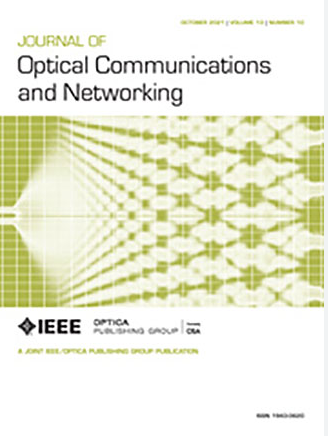On the design of efficient fiber-wireless architectures to enable multigigabit visible light communication
IF 4.3
2区 计算机科学
Q1 COMPUTER SCIENCE, HARDWARE & ARCHITECTURE
引用次数: 0
Abstract
The surge in demand for wireless communication has placed significant strain on existing radio networks, which are struggling to accommodate the rapidly increasing number of mobile and fixed wireless devices. In response to this challenge, industry and academia have collaborated to explore alternative radio access technologies capable of supporting this continuous growth. Visible light communication (VLC) has emerged as a promising alternative due to the hundreds of terahertz of unlicensed bandwidth available for wireless communication. Despite its undisputable potential for ultrahigh-speed communication, the interface between the VLC wireless access and the fiber distribution network is still largely unexplored. Notably, this issue becomes more challenging when dealing with multicolored VLC systems, such as those employing RGB multiplexing. Following this research gap, in this work, we focus our attention on the design of efficient optical/electrical interfaces that can synergistically merge the fiber and VLC sections of an integrated fiber-wireless network. To that end, two fundamental architectural options are proposed and experimentally assessed, resorting to either optical or electrical multiplexing of the VLC constituent colors. From our experimental analysis, similar RGB-VLC data rates of 13–15 Gbit/s could be achieved using both fiber-wireless interface architectures. The choice of the most adequate solution is then fundamentally dependent on a number of network design options and requirements. While electrical multiplexing is deemed to enable more spectrally efficient utilization of the fiber transport network, optical multiplexing provides a simpler infrared-to-visible interface using cost-efficient commercial off-the-shelf equipment.高效光纤无线架构设计,实现多千兆可见光通信
无线通信需求的激增给现有的无线网络带来了巨大的压力,这些网络正在努力适应迅速增加的移动和固定无线设备数量。为了应对这一挑战,工业界和学术界合作探索能够支持这种持续增长的替代无线电接入技术。可见光通信(VLC)已经成为一种有前途的替代方案,因为数百太赫兹的无许可带宽可用于无线通信。尽管超高速通信具有无可争议的潜力,但VLC无线接入和光纤分配网络之间的接口仍在很大程度上未被探索。值得注意的是,当处理多色VLC系统时,这个问题变得更具挑战性,例如那些采用RGB多路复用的系统。根据这一研究缺口,在本工作中,我们将重点放在设计有效的光/电接口上,该接口可以协同合并集成光纤无线网络的光纤和VLC部分。为此,提出了两种基本的架构选择并进行了实验评估,采用VLC组成颜色的光或电多路复用。从我们的实验分析来看,使用两种光纤无线接口架构都可以实现类似的13-15 Gbit/s的RGB-VLC数据速率。因此,选择最合适的解决方案从根本上取决于许多网络设计选项和需求。虽然电复用被认为能够更有效地利用光纤传输网络,但光复用使用经济高效的商用现成设备提供了更简单的红外到可见接口。
本文章由计算机程序翻译,如有差异,请以英文原文为准。
求助全文
约1分钟内获得全文
求助全文
来源期刊
CiteScore
9.40
自引率
16.00%
发文量
104
审稿时长
4 months
期刊介绍:
The scope of the Journal includes advances in the state-of-the-art of optical networking science, technology, and engineering. Both theoretical contributions (including new techniques, concepts, analyses, and economic studies) and practical contributions (including optical networking experiments, prototypes, and new applications) are encouraged. Subareas of interest include the architecture and design of optical networks, optical network survivability and security, software-defined optical networking, elastic optical networks, data and control plane advances, network management related innovation, and optical access networks. Enabling technologies and their applications are suitable topics only if the results are shown to directly impact optical networking beyond simple point-to-point networks.

 求助内容:
求助内容: 应助结果提醒方式:
应助结果提醒方式:


